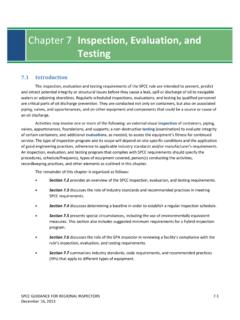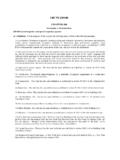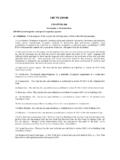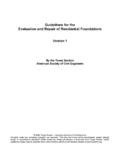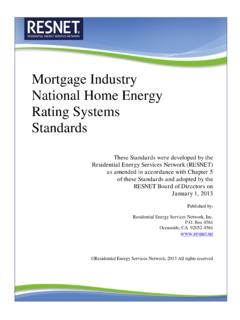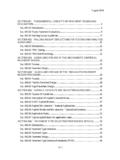Transcription of INSPECTION, EVALUATION AND TESTING 7.1 Introduction
1 chapter 7: inspection , EVALUATION , and TESTING inspection , EVALUATION , AND TESTING Introduction Regularly scheduled inspections, evaluations, and TESTING by qualified personnel are critical parts of discharge prevention. Their purpose is to prevent, predict, and readily detect discharges. They are conducted not only on containers, but also on associated piping, valves, and appurtenances, and on other equipment and components that could be a source or cause of an oil release. Activities may involve one or more of the following: an external visual inspection of containers, piping, valves, appurtenances, foundations, and supports; a non-destructive shell test to evaluate integrity of certain containers; and additional evaluations, as needed, to assess the equipment s fitness for continued service.
2 The type of activity and its scope will depend on the exercise of good engineering practice; not every action will necessarily be applicable to every facility and container, and additional inspections may be required in some cases. An inspection , EVALUATION , and TESTING program that complies with SPCC requirements should specify the procedures, schedule/frequency, types of equipment covered, person(s) conducting the activities, recordkeeping practices, and other elements as outlined in this chapter . The remainder of this chapter is organized as follows: Section provides an overview of the SPCC inspection , EVALUATION , and TESTING requirements.
3 Section discusses specific cases, including the use of environmentally equivalent measures. Section discusses the role of the EPA inspector in reviewing a facility s compliance with the rule s inspection , EVALUATION , and TESTING requirements. Section summarizes industry standards, code requirements, and recommended practices (RPs) that apply to different types of equipment. inspection , EVALUATION , and TESTING under the SPCC Rule Various provisions of the SPCC rule relate to the inspection , EVALUATION , and TESTING of containers, associated piping, and other oil-containing equipment.
4 Different requirements apply to different types of equipment and to different types of facilities. The requirements are generally aimed at preventing discharges of oil caused by leaks, brittle fracture, or other forms of container failure by ensuring that containers used to store oil have the necessary physical integrity for continued oil storage. The requirements are also aimed at detecting container failures (such as small pinhole leaks) before they can become significant and result in a discharge as described in (b).
5 Environmental Protection Agency 7-1 Version , 2/3/06 SPCC Guidance for Regional Inspectors Summary of inspection and Integrity TESTING Requirements Table 7-1 summarizes the provisions that apply to different types of equipment and facilities. Some inspection and TESTING provisions apply to bulk storage containers at onshore facilities (other than production facilities). inspection and/or TESTING requirements also apply to other components of a facility that might cause a discharge (such as vehicle drains, foundations, or other equipment or devices).
6 Other inspection requirements also apply to oil production facilities. In addition, inspection , EVALUATION , and TESTING requirements are required under certain circumstances, such as when an aboveground field-constructed container undergoes repairs, alterations, or a change in service that may affect its potential for a brittle fracture or other catastrophe, or in cases where secondary containment for bulk storage containers is impracticable ( (d), as described in chapter 4 of this document.) Facility owners and operators must also maintain corresponding records to demonstrate compliance ( (c)(6), (d)(4), (b)(2), (c)(3), and (d)(1) and (2)) per (e).
7 Table 7-1. Summary of SPCC inspection , EVALUATION , TESTING , and maintenance program provisions. Facility Component Section(s) Action Method, Circumstance, and Required Action General Requirements Applicable to All Facilities Bulk storage with no secondary containment and for which an impracticability determination has been made (d) Test Integrity Periodically. However, because there is no secondary containment, good engineering practice may suggest more frequent TESTING than would otherwise be scheduled.
8 Valves and piping associated with bulk storage containers with no secondary containment and for which an impracticability determination has been made (d) Test Integrity and leak TESTING of valves and piping associated with containers that have no secondary containment as described in (c). Periodically. Integrity TESTING is any means to measure the strength (structural soundness) of a container shell, bottom, and/or floor to contain oil, and may include leak TESTING to determine whether the container will discharge oil.
9 Integrity TESTING is a necessary component of any good oil discharge prevention plan. It will help to prevent discharges by TESTING the strength and imperviousness of containers, ensuring they are suitable for continued service under current and anticipated operating conditions ( , product, temperature, pressure). TESTING may also help facilities determine whether corrosion has reached a point where repairs or replacement of the container is needed, and thus avoid unplanned interruptions in facility operations.
10 (67 FR 47120) Environmental Protection Agency 7-2 Version , 2/3/06 1 chapter 7: inspection , EVALUATION , and TESTING Facility Component Section(s) Action Method, Circumstance, and Required Action Recordkeeping requirement (e) Record Keep written procedures and a signed record of inspections and tests for a period of three Records kept under usual and customary business practices will suffice. For all actions. Lowermost drain and all outlets of tank car or tank truck (h)(3) Inspect Visually inspect. Prior to filling and departure of tank car or tank truck.

